Domestic abuse: statistics recorded by the police in Scotland - 2012-13
This bulletin presents statistics on domestic abuse, based on details of incidents supplied by the eight Scottish police forces in 2012-13
This document is part of a collection
3. Commentary
The statistics on domestic abuse are used to inform National Outcome 9 - 'we live our lives safe from crime, disorder and danger' as well as The Strategy for Justice in Scotland. These statistics are also used by a wide range of stakeholders to monitor trends, for policy research and development, and for research purposes.
The Police and Fire Reform (Scotland) Act 2012 changed the policing landscape in Scotland, replacing the eight police forces, the Scottish Police Services Authority and the Scottish Crime and Drug Enforcement Agency from 1 April 2013. The Police Service of Scotland is now responsible for operational policing in Scotland and will be held to account by the Scottish Police Authority. The statistics set out in this bulletin cover the year immediately preceding the establishment of the Police Service of Scotland.
3.1. Incidents of domestic abuse recorded by the police (tables 1 and 2, and chart 1)
- Incidents of domestic abuse recorded by the police in Scotland increased from 59,847 in 2011-12 to 60,080 in 2012-13, an increase of less than half of 1% and continuing the generally upward trend.
- 50% (30,259) of the incidents recorded in 2012-13 led to the recording of at least one crime or offence. This is four percentage points lower than in 2011-12. In 2012-13, the highest proportion of crimes/offences to incidents was recorded by Grampian (66%) and the lowest by Lothian & Borders (34%).
- The most common crime or offence recorded in 2012-13, as in previous years, was Common assault, accounting for 42% (12,778) of all incidents where a crime or offence was recorded, followed by Threatening or abusive behaviour at 19% (5,685).
- Crimes, which are generally regarded as more serious than offences, were recorded in 12% (7,488) of all incidents in 2012-13, similar to the previous three year period in which the percentage remained constant at 13%.
- In 2012-13, where a crime was recorded, it was most likely to be a Crime against public justice (typically Bail offences and Resisting arrest), accounting for 13% (4,005) of all incidents where a crime or offence was recorded, or Vandalism, accounting for 6% (1,720).
- The Criminal Justice and Licensing (Scotland) Act 2010 introduced two new statutory offences, namely Threatening or abusive behaviour (section 38) and Stalking (section 39). These sections of the Act came into force in late 2010. These offences would previously have been recorded under Breach of the peace and therefore the recent decreases in the number of offences of Breach of the peace should be treated with caution.
3.2. Incidents of domestic abuse per 100,000 population (table 3)
- The number of domestic abuse incidents recorded by the police in 2012-13 ranged from 707 per 100,000 population in Grampian to 1,311 per 100,000 population in Fife, compared with an overall Scottish rate of 1,131 per 100,000 population.
- In 2012-13, Strathclyde has the highest number of domestic abuse incidents where a crime or offence was recorded (733 per 100,000 population), while Dumfries & Galloway and Lothian & Borders have the lowest (each 377 per 100,000 population).
- There was some variation between police forces in the number of incidents of domestic abuse which were reported to the procurator fiscal in 2012-13. These ranged from 217 per 100,000 population in Grampian, to 630 per 100,000 population in Strathclyde.
3.3. Incidents of domestic abuse by gender of victim and perpetrator (tables 6 and 7, and chart 2)
- Incidents with a female victim and a male perpetrator represented 80% of all incidents of domestic abuse in 2012-13 (where this information was recorded), one percentage point lower than in 2011-12. This percentage has gradually decreased since 2003-04, when it was 89%. This is mainly the result of an increase in the proportion of incidents with a male victim and a female perpetrator, which has risen from 9% of all incidents (where this information was recorded) in 2003-04 to 17% in 2012-13.
Chart 2 Gender of victim and perpetrator, where known, Scotland, 2003-04 to 2012-13.
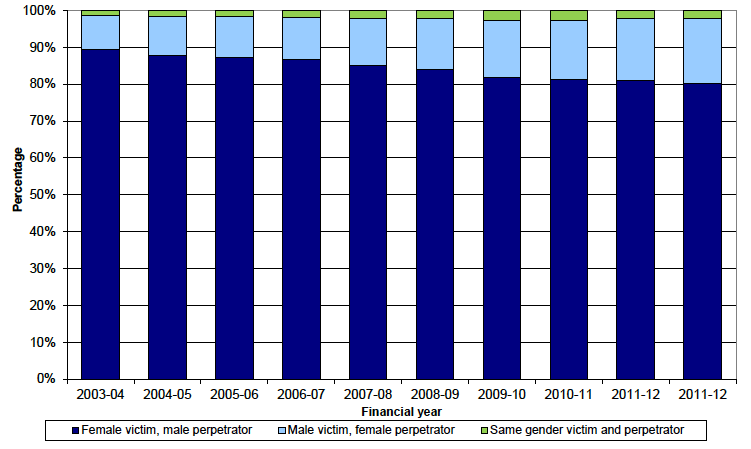
3.4. Level of repeat victimisation (tables 8, 9, and 10)
- For incidents where information regarding repeat victimisation of domestic abuse was available in 2012-13, 61% of the incidents involved known repeat victimisation, the same as in 2011-12, and compared to 47% in 2003-04. The increase since 2003-04 may be in part due to the length of time different forces have kept databases on domestic abuse, allowing repeat incidents to be identified.
- In 2012-13, where the number of previous incidents was known, 30% of cases involved a single previous incident, 30% of cases involved two or three previous incidents, and 39% involved four or more previous incidents. Please note that these are counts of incidents - victims of repeat abuse over the financial year period may be may be counted on more than one occasion as the numbers of previous incidents increases (see note 4.4).
3.5. Incidents of domestic abuse by age of victim and perpetrator (tables 11, 12, and 13, and chart 3)
- In 2012-13, the highest rate of incidents of domestic abuse per 100,000 population among female victims was for those aged 22 to 25 years, where the rate was 4,937 incidents per 100,000 population. This is the same age group as in 2011-12, where the rate was 5,061 incidents recorded per 100,000 population.
- Among male victims, the highest rate of incidents of domestic abuse per 100,000 population in 2012-13, was for those aged, 26-30 years, where the rate was 1,004 incidents per 100,000 population. In 2011-12, the highest rate of incidents among male victims was for those aged 31 to 35 years 2011-12, where the rate was 964 per 100,000 population.
Chart 3 Rate per 100,000 population of incidents of domestic abuse, by age and gender of victim, where known, Scotland, 2012-13.
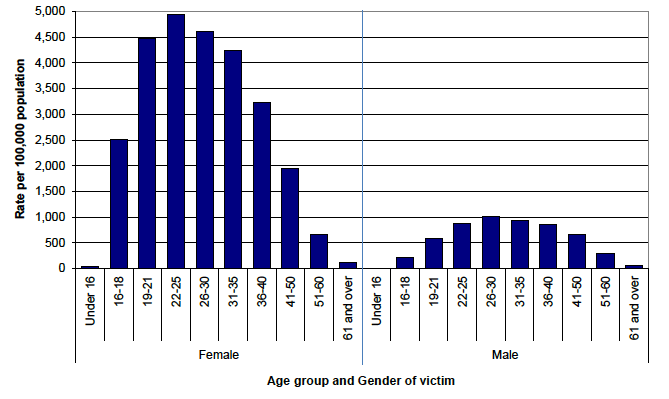
- In 2012-13, the highest rate of incidents of domestic abuse per 100,000 population among female perpetrators was by those aged 22 to 25 years, where the rate was 990 incidents per 100,000 population. This has changed from 2011-12 where the highest rate per 100,000 population of female perpetrators was by those aged 26 to 30 years, at a rate of 988 incidents per 100,000 population.
- Among male perpetrators, the highest rate of incidents of domestic abuse per 100,000 population in 2012-13 was by those aged 26 to 30 years, where the rate was 4,835 incidents per 100,000 population. This is the same age group as in 2011-12 where the rate was 4,877 incidents recorded per 100,000 population.
3.6. Incidents of domestic abuse by relationship between victim and perpetrator (table 17)
- Since 2003-04, the percentage of incidents involving spouses has decreased from 22% to 13% in 2012-13. There has also been a decrease in the percentage of incidents involving cohabitees from 26% in 2003-04 to 19% in 2012-13.
- In 2012-13, incidents of domestic abuse recorded by the police involving partners accounted for 23% of all incidents where the relationship was recorded. This percentage has been increasing since 2003-04 where partners accounted for 17% of domestic abuse incidents.
- In 44% of incidents where the relationship was recorded in 2012-13, the victim and perpetrator were ex-partners or ex-spouses. This figure has been increasing since 2003-04, when 32% of incidents involved ex-partners/ex-spouses. 'Other' relationships include relationships not fitting into specified categories.
3.7. Location of incidents of domestic abuse (tables 18, 19 and 20 and chart 4)
- In 87% of incidents in 2012-13 where the location was recorded, domestic abuse took place in a home/house. Where the victim and perpetrator cohabited i.e. were a 'spouse' or 'cohabitee', 93% of all incidents recorded were in a home/house, where location and relationship were recorded.
- In all other relationships, excluding those of a 'spouse' or 'cohabitee', 84% of all incidents in 2012-13 (where the relationship and location were recorded) took place in a home/house. This shows that the overwhelming majority of domestic abuse incidents take place 'behind closed doors'.
Chart 4 Incidents of domestic abuse recorded by the police: location of incident by relationship (where known), Scotland, 2012-13.
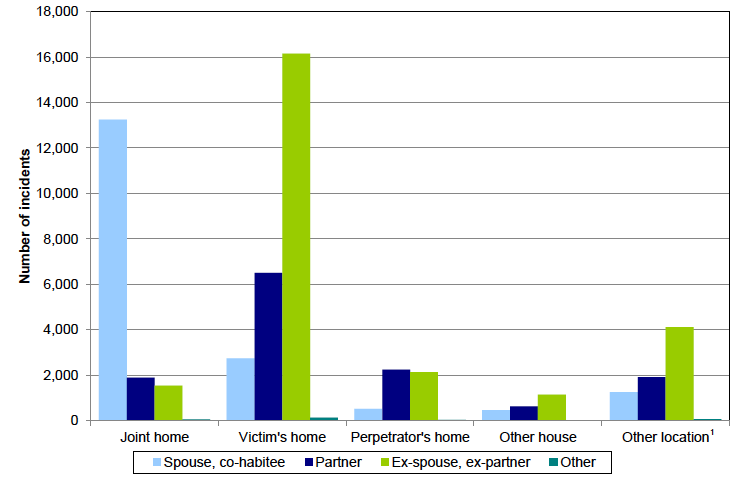
1. Other location includes street and licensed premises.
3.8. Crimes and offences of domestic abuse, action taken by police (tables 1, 2, 21, and 22, and chart 5)
- Where an incident of domestic abuse resulted in a crime or offence being recorded, a report was submitted to the procurator fiscal in 78% of incidents in 2012-13, a substantial increase from 51% in 2003-04.
- In 2012-13, where a report was not submitted to the procurator fiscal but the action taken was known, 17% of incidents involved some other type of action and in 5% of incidents no further action was taken.
- In 2012-13, the proportion of crimes and offences of domestic abuse referred to the procurator fiscal varied considerably across police force areas. The percentages ranged from 47% in Grampian, to 92% in Northern. This variation may reflect the differences in police practice in deciding when the behaviour justifies the recording of a crime/offence following an incident of domestic abuse (see note 4.5).
Chart 5 Action taken by the police for crimes/offences cleared up, by police force area, 2012-13
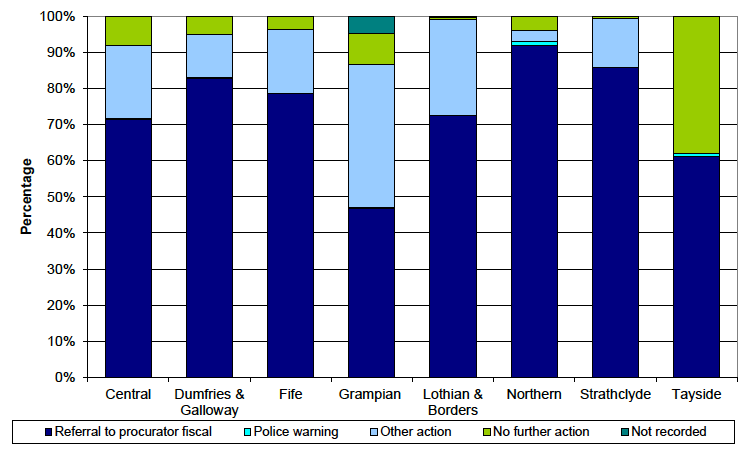
3.9. Day of occurrence of domestic abuse incidents (table 24 and chart 6)
- More incidents of domestic abuse take place at the weekend than during the week. 37% of all incidents of domestic abuse in 2012-13 occurred on a Saturday or a Sunday, with the remaining 63% spread fairly evenly throughout the rest of the week.
Chart 6 Incidents of domestic abuse recorded by the police: day of week incident occurred, Scotland 2012-13.
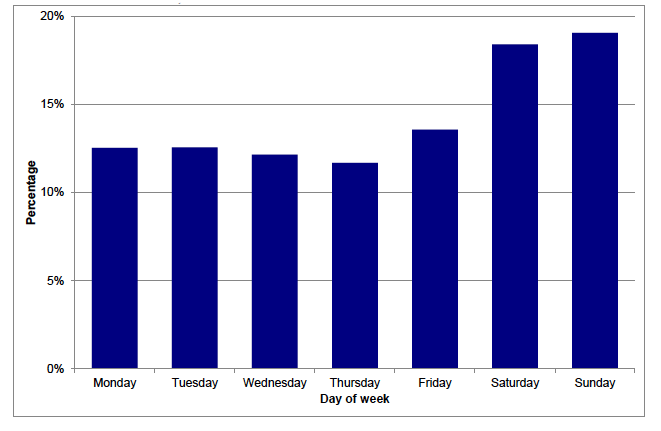
Contact
Email: Jan Young
There is a problem
Thanks for your feedback